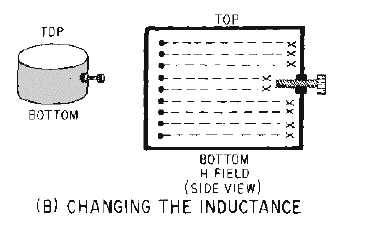1-50
Figure 1-63B.—Methods of changing the resonant frequency of a cavity. CHANGING THE INDUCTANCE.
INDUCTIVE TUNING is accomplished by placing a nonmagnetic slug in the area of maximum H
lines, as shown in figure 1-63B. The changing H lines induce a current in the slug that sets up an
opposing H field. The opposing field reduces the total H field in the cavity, and therefore reduces the total
inductance. Reducing the inductance, by moving the slug in, raises the resonant frequency. Increasing the
inductance, by moving the slug out, lowers the resonant frequency.
Resonant cavities are widely used in the microwave range, and many of the applications will be
studied in chapter 2. For example, most microwave tubes and transmitting devices use cavities in some
form to generate microwave energy. Cavities are also used to determine the frequency of the energy
traveling in a waveguide, since conventional measurement devices do not work well at microwave
frequencies.
Q-50. What two variables determine the primary frequency of a resonant cavity?
Q-51. Energy can be inserted or removed from a cavity by what three methods?
Q-52. Inductive tuning of a resonant cavity is accomplished by placing a nonmagnetic slug in what
area?
Waveguide Junctions
You may have assumed that when energy traveling down a waveguide reaches a junction, it simply
divides and follows the junction. This is not strictly true. Different types of junctions affect the energy in
different ways. Since waveguide junctions are used extensively in most systems, you need to understand
the basic operating principles of those most commonly used.
The T JUNCTION is the most simple of the commonly used waveguide junctions. T junctions are
divided into two basic types, the E-TYPE and the H-TYPE. HYBRID JUNCTIONS are more
complicated developments of the basic T junctions. The MAGIC-T and the HYBRID RING are the two
most commonly used hybrid junctions.
E-TYPE T JUNCTION.—An E-type T junction is illustrated in figure 1-64, view (A). It is called
an E-type T junction because the junction arm extends from the main waveguide in the same direction as
the E field in the waveguide.

